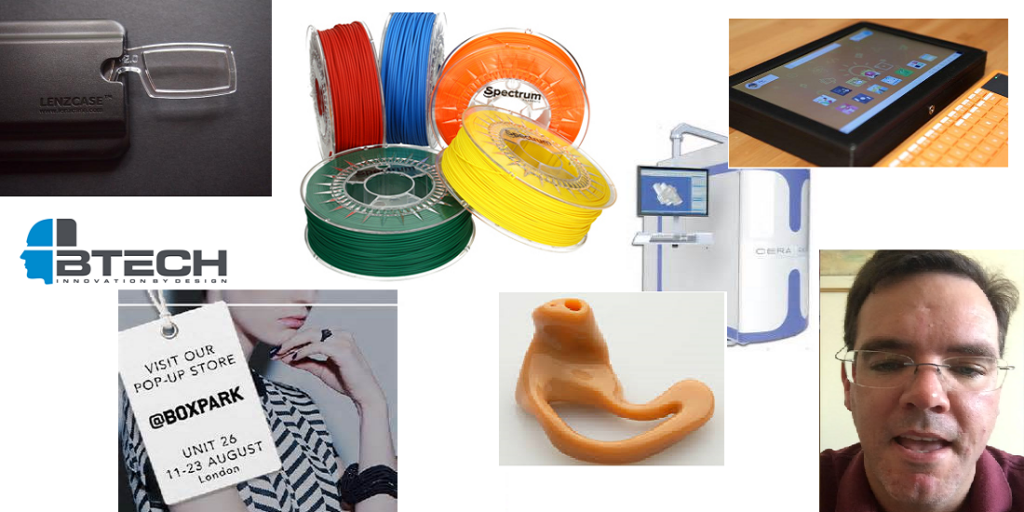There’s lots of 3D printing business news this week. Gartner Inc., the world’s largest research and advisory company for information technology, reports that medicine is the sector most influenced by 3D printing technology. Also, a Facebook executive has joined the board of MyMiniFactory, Turkey’s BTech Innovation is expanding in several directions, the ceramic 3D printer Ceramaker will be displayed at Euromold 2015, and Poland’s Spectrum Filaments is planning on distributing its high-quality colorful filaments internationally. With all of this support for 3D printing, the UK WonderLuk on-line platform for 3D designers is planning a pop-up shop leading up to London’s Fashion Week. And, we kick the whole review off with a 3D printed tablet from Adafruit that makes good use out of the Raspberry Pi computer board, and a new 3D printed smartphone case that also holds a pair of reading glass lenses.
Adafruit’s Fully Customizable 3D Printable Tablet
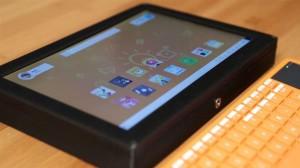 Adafruit’s Ruiz Brothers have done it again: this time they are providing us with the opportunity to 3D print your own computer tablet, using the Raspberry Pi computer board. While the brothers plan to use their tablet to monitor a 3D print farm, there are many uses and applications for this 3D printed tablet that is fully customizable, mountable to many applications, and cheaper to make than many store-bought tablets. The tablet’s whole body has been 3D printed on their Type A Machine Series 1 in about 12 hours, and they used Simplify3D software to design it. The four separate STL files used a 10% infill and three shells. Also, you can use PLA and ABS filament to print these tablet parts, or experiment with other filaments too. Sounds like another great 3D printable project compliments of the Ruiz Brothers.
Adafruit’s Ruiz Brothers have done it again: this time they are providing us with the opportunity to 3D print your own computer tablet, using the Raspberry Pi computer board. While the brothers plan to use their tablet to monitor a 3D print farm, there are many uses and applications for this 3D printed tablet that is fully customizable, mountable to many applications, and cheaper to make than many store-bought tablets. The tablet’s whole body has been 3D printed on their Type A Machine Series 1 in about 12 hours, and they used Simplify3D software to design it. The four separate STL files used a 10% infill and three shells. Also, you can use PLA and ABS filament to print these tablet parts, or experiment with other filaments too. Sounds like another great 3D printable project compliments of the Ruiz Brothers.
New Lenzcase Holds More Than Your iPhone
 Smartphone cases are a common thing in the 3D printing space. They are relatively easy to print, and they can be immediately used, and used all the time too. And the designs just keep getting sharper. A couple from Australia, Steve and Cheryl Grealy, have innovated a new use of the 3D printed smartphone case: they developed Lenzcase, which is a case for your phone and reading glasses! The case is not for any pair of glasses: it comes with four different strength spring-loaded glass lenses to be used in the instance where you find yourself straining to read something. If you need your reading glasses out, but realize you’ve left them at home, this is the perfect solution for you. Just take them out of the Lenzcase, use them, pop them right back in and you are good to go! Just don’t forget your Lenzcase at home! If you like this idea, you can go to Lenzcase’s Kickstarter page where they are trying to raise $28,000 by September 29–early backers can get a Lenzcase for just $28, well below the eventual retail price of $79.90.
Smartphone cases are a common thing in the 3D printing space. They are relatively easy to print, and they can be immediately used, and used all the time too. And the designs just keep getting sharper. A couple from Australia, Steve and Cheryl Grealy, have innovated a new use of the 3D printed smartphone case: they developed Lenzcase, which is a case for your phone and reading glasses! The case is not for any pair of glasses: it comes with four different strength spring-loaded glass lenses to be used in the instance where you find yourself straining to read something. If you need your reading glasses out, but realize you’ve left them at home, this is the perfect solution for you. Just take them out of the Lenzcase, use them, pop them right back in and you are good to go! Just don’t forget your Lenzcase at home! If you like this idea, you can go to Lenzcase’s Kickstarter page where they are trying to raise $28,000 by September 29–early backers can get a Lenzcase for just $28, well below the eventual retail price of $79.90.
New Online Platform for 3D Designers
 WonderLuk is a new online platform that wants to serve as a bridge between 3D designers and the buying public of 3D printed consumer items. Architects as well as car, jewelry, fashion, and industrial designers are the targets for this new platform that wants to help them make and sell their 3D printed collections. While the company has been around since 2013, WonderLuk is hosting its first 3D printed jewelry pop-up shop in Boxpark, Shoreditch – which is taking place the 11th through the 23rd, ahead of London’s Fashion Week. There is much interest in WonderLuk, which receives about 100 applications a month from designers–but they can only take 5 or 6 of those 100 applications. If you are lucky enough to be selected, you get to do your thing, design, while receiving support from an in-house design team.
WonderLuk is a new online platform that wants to serve as a bridge between 3D designers and the buying public of 3D printed consumer items. Architects as well as car, jewelry, fashion, and industrial designers are the targets for this new platform that wants to help them make and sell their 3D printed collections. While the company has been around since 2013, WonderLuk is hosting its first 3D printed jewelry pop-up shop in Boxpark, Shoreditch – which is taking place the 11th through the 23rd, ahead of London’s Fashion Week. There is much interest in WonderLuk, which receives about 100 applications a month from designers–but they can only take 5 or 6 of those 100 applications. If you are lucky enough to be selected, you get to do your thing, design, while receiving support from an in-house design team.
3D Ceramics Printer Ready for Euromold 2015
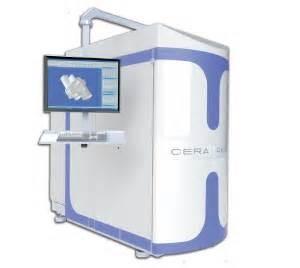 Ceramics is an innovative 3D printing material that the company 3DCeram has studied extensively, resulting in a ceramics 3D printing process called Ceramics Additive Manufacturing (CAM). The printing process uses a photosensitive resin mixed with ceramic particles which creates a paste that becomes polymerized in the laser printing process. A UV laser cures each of the layers, which range from 25 to 100 micron thickness, and each layer sticks to the previous one, building up the object. In September, the CERAMAKER printer will be displayed at the Euromold trade show in Dusseldorf. This means ceramic printing may become more common, due to innovations like the CERAMAKER 3D printer.
Ceramics is an innovative 3D printing material that the company 3DCeram has studied extensively, resulting in a ceramics 3D printing process called Ceramics Additive Manufacturing (CAM). The printing process uses a photosensitive resin mixed with ceramic particles which creates a paste that becomes polymerized in the laser printing process. A UV laser cures each of the layers, which range from 25 to 100 micron thickness, and each layer sticks to the previous one, building up the object. In September, the CERAMAKER printer will be displayed at the Euromold trade show in Dusseldorf. This means ceramic printing may become more common, due to innovations like the CERAMAKER 3D printer.
Gartner Inc. Shows 3D Printing’s Impact in Medicine
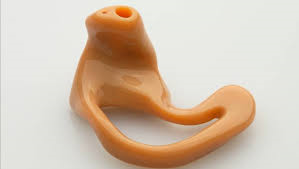 Stamford, Connecticut-based Gartner Inc. has released a report confirming something that we kind of already knew: 3D printing technology is making leaps and bounds in medical applications. From hearing aids to dental devices, 3D printed organ replicas, prostheses, hip and knee replacements, and even the bioprinting of human tissue, we have seen some of the most creative applications of 3D printing in the medical arena. Gartner is the world’s leading information technology research and advisory company, and it notes that 3D printable medical devices require very complex systems, so this will still be limited to specialist service providers instead of more mainstream adoption. But Gartner’s report does predict a wider adoption of 3D printing in the next five years, outside specialist fields. The decreased cost of scanning and the ability for consumers to make their own printed items are two of the reasons Gartner cites for greater 3D printing adoption in the medical field.
Stamford, Connecticut-based Gartner Inc. has released a report confirming something that we kind of already knew: 3D printing technology is making leaps and bounds in medical applications. From hearing aids to dental devices, 3D printed organ replicas, prostheses, hip and knee replacements, and even the bioprinting of human tissue, we have seen some of the most creative applications of 3D printing in the medical arena. Gartner is the world’s leading information technology research and advisory company, and it notes that 3D printable medical devices require very complex systems, so this will still be limited to specialist service providers instead of more mainstream adoption. But Gartner’s report does predict a wider adoption of 3D printing in the next five years, outside specialist fields. The decreased cost of scanning and the ability for consumers to make their own printed items are two of the reasons Gartner cites for greater 3D printing adoption in the medical field.
Facebook Executive Joins MyMiniFactory Board
 As 3D printing gets recognized for its great contributions in the medical arena, there’s also evidence that more people are catching onto its widening impact in other sectors too. Take social media. Facebook’s Head of Retail & E-Commerce, Nicholas Franchet, has joined 3D printable models site MyMiniFactory’s Board of Directors. This development reflects the growing awareness of the significant role that 3D printing will play in the “way people interact with products,” Franchet explained in a video. MyMiniFactory has many community members and models, so it seems like a great choice for a social media executive who views 3D printing as the next big thing in consumer proucts. You can view the video of Franchet’s announcement about this move here.
As 3D printing gets recognized for its great contributions in the medical arena, there’s also evidence that more people are catching onto its widening impact in other sectors too. Take social media. Facebook’s Head of Retail & E-Commerce, Nicholas Franchet, has joined 3D printable models site MyMiniFactory’s Board of Directors. This development reflects the growing awareness of the significant role that 3D printing will play in the “way people interact with products,” Franchet explained in a video. MyMiniFactory has many community members and models, so it seems like a great choice for a social media executive who views 3D printing as the next big thing in consumer proucts. You can view the video of Franchet’s announcement about this move here.
Turkey’s BTech Innovation Expands Offerings
 In other 3D printing business news, Turkey’s BTech Innovation, known for its contributions to medical engineering, has expanded its company by making available Arcam’s electronic beam melting machines. These machines use a variety of powders–like cobalt alloy and titanium–to 3D print metal parts. Also, BTech Innovation will be selling Materialise’s Mimics Innovation Suite, which is software used to change radiological data into 3D printable files. BTech’s chief executive notes that the fact that the company uses the products it now intends to sell has it “presenting a different approach and support” to its customers. In addition to deals with Arcam and Materialise, BTech will also sell hardware from MassPortal, EnvisionTEC, BuildTak and Polymaker. These expanded deals with Arcam and Materialise have BTech hoping that this will continue its prominent position in Turkey’s 3D printing space–also influencing 3D printing internationally.
In other 3D printing business news, Turkey’s BTech Innovation, known for its contributions to medical engineering, has expanded its company by making available Arcam’s electronic beam melting machines. These machines use a variety of powders–like cobalt alloy and titanium–to 3D print metal parts. Also, BTech Innovation will be selling Materialise’s Mimics Innovation Suite, which is software used to change radiological data into 3D printable files. BTech’s chief executive notes that the fact that the company uses the products it now intends to sell has it “presenting a different approach and support” to its customers. In addition to deals with Arcam and Materialise, BTech will also sell hardware from MassPortal, EnvisionTEC, BuildTak and Polymaker. These expanded deals with Arcam and Materialise have BTech hoping that this will continue its prominent position in Turkey’s 3D printing space–also influencing 3D printing internationally.
Poland-Based Spectrum Filaments Plans to Release Filament Internationally
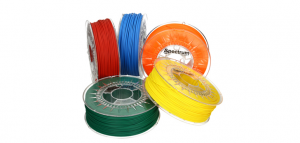 Spectrum Filaments is a Polish company that makes filament for FDM 3D printers. Their line of high-quality and very colorful filaments has earned a good reputation in Poland, but the company also plans to release its products to the broader 3D printing international community. Carrying ABS, PLA, and other materials, you can custom order a filament color that you need for a special project. Spectrum Filaments’ materials come in 1.75 and 2.90 mm diameter on transparent rolls weighing 0.85 kg. One reel costs about €22.90. With such a cost-effective, high-quality, and colorful product line, Spectrum Filaments’ plan to expand to international markets–such as Germany, Austria, the UK, France, Russia, the Netherlands, Italy, and Sweden–seems like a good business move!
Spectrum Filaments is a Polish company that makes filament for FDM 3D printers. Their line of high-quality and very colorful filaments has earned a good reputation in Poland, but the company also plans to release its products to the broader 3D printing international community. Carrying ABS, PLA, and other materials, you can custom order a filament color that you need for a special project. Spectrum Filaments’ materials come in 1.75 and 2.90 mm diameter on transparent rolls weighing 0.85 kg. One reel costs about €22.90. With such a cost-effective, high-quality, and colorful product line, Spectrum Filaments’ plan to expand to international markets–such as Germany, Austria, the UK, France, Russia, the Netherlands, Italy, and Sweden–seems like a good business move!
That rounds out this week’s look at some of the news in 3D printing. Let us know if any of these struck a chord with you in the Stories We Missed forum thread over at 3DPB.com.
Subscribe to Our Email Newsletter
Stay up-to-date on all the latest news from the 3D printing industry and receive information and offers from third party vendors.
Print Services
Upload your 3D Models and get them printed quickly and efficiently.
You May Also Like
Making Space: Stratasys Global Director of Aerospace & Defense Conrad Smith Discusses the Space Supply Chain Council
Of all the many verticals that have been significant additive manufacturing (AM) adopters, few have been more deeply influenced by the incorporation of AM into their workflows than the space...
EOS in India: AM’s Rising Star
EOS is doubling down on India. With a growing base of aerospace startups, new government policies, and a massive engineering workforce, India is quickly becoming one of the most important...
PostProcess CEO on Why the “Dirty Little Secret” of 3D Printing Can’t Be Ignored Anymore
If you’ve ever peeked behind the scenes of a 3D printing lab, you might have caught a glimpse of the post-processing room; maybe it’s messy, maybe hidden behind a mysterious...
Stratasys & Automation Intelligence Open North American Tooling Center in Flint
Stratasys has opened the North American Stratasys Tooling Center (NASTC) in Flint, Michigan, together with automation integrator and software firm Automation Intelligence. Stratasys wants the new center to help reduce...


